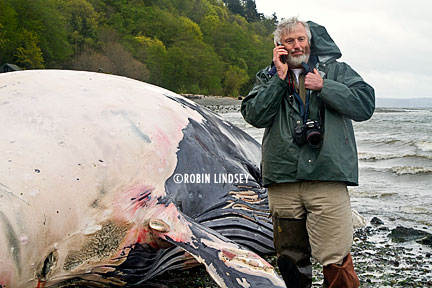Dead fin whale washes ashore in Burien, victim of ship strike
Apr/13/13 11:57 PM

A dead adult fin whale, the apparent victim of a ship strike, washed onto the beach of Seahurst Park mid-morning today. Biologist Dyanna Lambourn and interns from WA Dept. of Fish and Wildlife Marine Mammal Investigations (WDFW-MMI), Cascadia Research biologists John Calambokidis and Jessie Huggins, and staff and students from MaST Center of Highline Community College examined the whale and answered questions from the public. Seal Sitters volunteers participated as well.
Most of the rear half of the whale was missing, but the animal was estimated to have been approximately 65 ft in length when intact. Fin whales are the second largest species of whales with a maximum length of 75 ft. Bruising from brunt force trauma is an indication that the whale was still alive when struck by the bow of a large ship. Red paint from the ship was on the whale’s body. Fin whales, an endangered species, are susceptible to mortal wounds because of their size and their tendency to feed near the water’s surface. Since 2002, Cascadia reports there have been 10 stranded fin whales in Washington waters, 8 of which had evidence of vessel collisions (including today’s whale).
These large baleen whales are vulnerable to ship strikes as they travel in waters along our Pacific coast, particularly in busy shipping lanes such as Los Angeles and Long Beach, California. Gray whales and their calves migrate from Baja California to Alaska through these containership congested waters. Blue whales, the largest of all cetaceans and listed as endangered, are in peril of deadly collisions as they forage on krill in the shipping lanes. In 2007, three blue whales were struck and killed by ships in the Santa Barbara Channel.

The WDFW-MMI and Cascadia team is making efforts to have the animal towed to a remote location for necropsy. Read Cascadia’s preliminary report here. Studies by both Cascadia and WDFW-MMI on whales and vessel interactions can be found on Cascadia’s website.
Responses such as this by members of NOAA’s NW Marine Mammal Stranding Network are in large part funded by the John H. Prescott Fund, which has been eliminated from the 2014 fiscal year Federal budget. Contact your congressional representative here, asking that this critical funding be restored.
RELATED NEWS MEDIA LINKS
KING 5 TV
KOMO 4 TV
UPDATE 4/15/13
NOAA’s NW Marine Mammal Stranding expert reports that they are working with several groups, including the City of Burien and Burien Parks and Recreation, to find a solution to both crowd control and the removal the fin whale at Seahurst Park. Large whale strandings are extremely complicated situations, usually taking 3-5 days to resolve. Since the backbone and rear half of the whale is missing, towing the whale either to another location for necropsy or to sink in the Sound is difficult. There is no fluke to tie rope to and towing the whale by the head causes too much drag for most vessels to handle. NOAA is trying to find an educational or scientific facility interested in obtaining the skull.
After a chaotic Sunday with hundreds of onlookers at the beach, many touching and climbing on the whale, Parks is establishing a tape perimeter with signage, in hopes to keep people safely away from the immense whale. Marine mammals can carry infectious disease. Touching the animal carcass or blood and bodily fluids is inherently dangerous. Please admire this magnificent whale from a safe distance.







